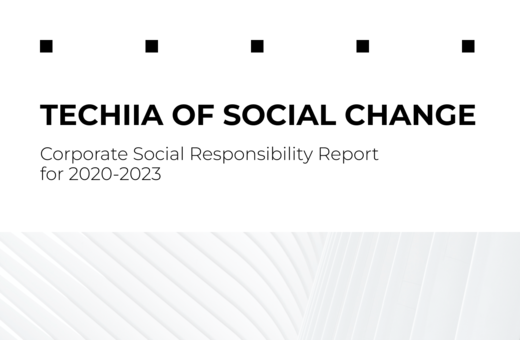
About why charity is useful for business and what projects it should focus on.

Oleg Krot, an investor, the Managing Partner of the international holding TECHIIA
“It’s only the giving that makes you what you are” – Ian Anderson. This quote originates back to 1971, at the rise of leftist ideology that gave Anderson’s love song a second meaning,
And now, 50 years later, this quote is still relevant. Thinking of the changes that our society faces right now, a line from Anderson’s song could easily become the motto of many companies. After all, today it is no longer possible to run a successful business and not be engaged in charity work.
However, not all charity events are equal. Sometimes funds allocated for a presumably good deed turn out to be reputational damage for the company.
Let’s try to determine which projects are worth participating in and which ones should be avoided.
A Charity Boom
Philanthropy has never experienced such an upsurge. Last year from January to June in the UK, the public donated £5.4 billion to charities. This is £800 million more than during the same period in 2019. In the United States, $471 billion was raised in 2020, which is a historic maximum in terms of the number of funds raised.
Despite the economic crisis, donations have increased significantly. Analysts determine a pandemic and a huge number of new online tools that facilitate the transfer of funds as the factors of the philanthropic boom.
Modern, intuitively simple online donation systems have provoked a certain trend for donations attached to checks in restaurants and retail networks. For example, in the UK online donations increased by 32% over the past year.
But the main factor is the changing paradigm of philanthropy. Nowadays charity is perceived not as a set of individual actions, but as a lifestyle. Making financial decisions on a daily basis, progressive citizens are guided by the “Social Good” concept.
Charity and PR
For many years the phenomenon of philanthropy has been studied by historians, psychologists, sociologists, economists. And each gives it a new definition.
For example, Allen Lux, an American lawyer, volunteer, and author of philanthropy books, describes charity as a practice that generates the feeling of “helpers high”.
James Andreoni, a professor of economics at the University of California, San Diego, shares the same opinion, calling the satisfaction of helping another a “warm glow”.
Both agree that philanthropy implies certain immediate benefits for the donor and in no way is altruism.
In the case of individual donations, this mechanism can be an excellent motivating factor. But for business, this model can no longer be applied. Consumers don’t like it when a company is trying to whip up their loyalty by investing in high-profile social projects.
Here’s an example. In April 2019, a French billionaire François-Henri Pinault, whose Kering company owns luxury brands Gucci, Balenciaga, Yves Saint Laurent, donated €100 million to renovate Notre Dame de Paris, which was damaged by the fire.
However, instead of recognition, the businessman faced a storm of criticism. Here is the list of reasons:
- PR investments in tragedy;
- a demonstrative choice – he did not pay any attention to the National Museum of Brazil in Rio de Janeiro, which burned down six months before Notre Dame, although he could help;
- insufficient taxation – skeptics argued that François-Henri and other French billionaires pay fewer taxes than they should, and precisely because of this, in their opinion, the government does not have its own funds for repairs;
- spending a significant amount on a socially useless project – some say, €100 million could be spent on more important projects, such as helping the poor.
For Pinault, this story did not end well: after the scandal, Kering shares went down 12%. Of course, any CEO will do his/her best to promote the company. But the way François-Henri did it was obviously wrong.
Strategic Philanthropy for a Complex World
Here’s another definition of philanthropy: “Philanthropy is the private giving of time or valuables for public purposes” as stated by Lester Salamon, economist, and Director of the Center for Civil Society Studies at The Johns Hopkins Institute for Health and Social Policy Studies.
It is difficult to disagree with this definition. But how can it be applied to business objectives, the main of which is profit generation?
This is answered by a concept called Strategic Philanthropy. The main point here is that the company does not throw money in order to earn the trust of customers, but solves important social problems. If society benefits from these initiatives, so do the business.
The target audience of such projects is always the same – a community living in the area where the business operates. Let’s say you are doing business in Vietnam. This means that it is worth investing in the development of Vietnamese infrastructure. You can’t do business without clients. By improving the standard of living in a particular region, you create the foundation of your company’s growth.
It is clear that the larger the scale of the corporation, the more global projects it can cover. The Virgin Unite foundation of British billionaire Richard Branson is the perfect example. It implements charitable initiatives in different parts of the world, and the problems it solves are quite similar: reducing the global warming effect, providing medical assistance to the poor, and fighting discrimination of any kind.
One of the global projects is the vaccination of children living in remote corners of the world. “Despite huge progress in recent decades, 19 million children around the world are still missing out on basic life-saving vaccines every year,” said Richard Branson.
The project started in Kenya, Liberia, and Uganda, those countries where doctors don’t even have phones. To solve the problem, Branson proposed equipping health workers with smartphones, so that they can make maps, marking children in need of immunization, and recording their status.
In addition, smartphone-armed doctors in these areas will be able to upgrade their skills through Community Health Academy’s online courses, a project designed to support community health professionals in poor countries.
There is more pragmatism in Branson’s actions than it might seem at first glance. A study by Fidelity Charitable shows that philanthropists have redefined what social problems need to be addressed first. Basic health care is second only to hunger on this list.
Therefore, Sir Richard’s initiative is also a fine work with public expectations. A perfect example of a proper PR. And, it is difficult to reproach Branson for spending money on a useless project, don’t you agree?
Local Strategic Philanthropy
The scale of strategic philanthropy can be different depending on the size of the business: some run global projects, others work in the areas where their business operates.
But everyone who participates in such projects is united by one thing – no one expects an instant return from participation in such projects. It is no coincidence that there’s a word “strategic” in this concept. This is an attempt to solve systemic problems, and not fulfill the wishes of local communities. It is always an investment in the future.
Branson’s example shows that one of the highest priority vectors for philanthropists is to improve health care. Health is a basic value. This is why medical projects will always be the right option to invest in.
In the past year, we have seen the development of such projects throughout the UK. The most noticeable of these is a $15.6 million donation to the National Health Service from Hugh Grosvenor, who was recently the richest Briton and now ranks third in the Bloomberg rankings after James Dyson and Jim Ratcliffe.
In Ukraine, where our business is located, we support high-load medical centers and programs to fight childhood cancer. The holding also supports narrow but important initiatives – for example, an inclusion and correction center for children with disabilities and children who have undergone cancer treatment.
However, investing in projects related to medicine is not the only option for helping local communities. Educational and infrastructure projects are still of high importance.
It doesn’t matter which charitable vector you choose. It is important to understand whether you help the community. If the community thrives, so does the business. And vice versa.
What about ignoring philanthropy?
Charity is a global trend. Going against it is like swimming against the tide.
Baby boomer billionaires age and pass on their capital to the next generation. And here’s what is interesting: 35% of boomers consider themselves philanthropists, while generation X’s number is 48%. We will soon see the Baby Boomers hand over $68 trillion to their successors. That is, there will be even more money for charitable projects, and business, whether it wants it or not, will have to follow this trend.
Here are some numbers that show that businesses need to get involved in socially significant initiatives.
- 59% of working Britons believe that companies should invest in charitable projects;
- 68% of online audiences would stop buying brand products due to poor corporate social responsibility policies, which also include philanthropy;
- the number of charities in the UK is growing – in England and Wales alone, there are 170,000 such companies today, 1,700 more compared to last year.
Don’t Think About Philanthropy, But Build Loyalty
As we can see, philanthropy has become a must-have business tool. The main thing is not to perceive it as a way to get bonuses quickly.
Brand trust is formed differently nowadays. Check out the challenging strategy that Warby Parker has come up with.
In 2010, this company started producing inexpensive designer glasses. At the same time, Warby Parker immediately launched the Buy One, Give One Campaign. The company donates half of all glasses produced to charity (today 1 billion people worldwide cannot afford to buy glasses).
The company’s client base grew by leaps and bounds. Buyers knew that when buying a pair of Warby Parker glasses, they provided glasses to one underprivileged, and their loyalty increased dramatically.
In the final round in August last year, the company raised $120 million ($534 million in total), and its value is now estimated at $3 billion.
A remarkable story, isn’t it? But in order to follow the chosen concept, it takes courage and faith that the chosen strategy will work. And it completely did in the Warby Parker case.
It will take a long time to feel the return on your investment in charity. I would like to emphasize that: focusing on the effect for business vanishes the charity. The maximum possible number of people should get the maximum benefit. And this is what the main goal should be.
Original article on


